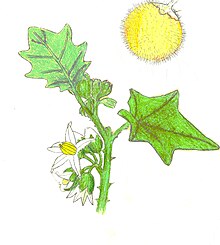Solanum lasiocarpum
| Solanum lasiocarpum | |
|---|---|
 |
|
| A drawling of Solanum lasiocarpum. | |
|
NE
|
|
| Scientific classification | |
| Kingdom: | Plantae |
| (unranked): | Angiosperms |
| (unranked): | Eudicots |
| (unranked): | Asterids |
| Order: | Solanales |
| Family: | Solanaceae |
| Genus: | Solanum |
| Species: | S. lasiocarpum |
| Binomial name | |
|
Solanum lasiocarpum Dunal 1813 |
|
Solanum lasiocarpum, otherwise known as Indian nightshade, is a plant that produces edible fruit. Its flowers are white and its fruits are pale yellow. S. lasiocarpum is native to temperate Asia, tropical Asia and the pacific.
S. lasiocarpum is found wild in parts of South Asia, but in a handful of countries it is primarily known as a domesticated plant. Domesticated plants bear larger fruits and lack the prickly skin that is found in the wild plants. The color found in the center of fruit is light green, like that of Solanum quitoense. It's cultivated in tropical Asia, used in food additives for flavoring, and given to the sick as a folk medicine. In India, the locals use the fruit as a sour-relish in curries. In Thailand, a special kind of sauce called nam prek is made with the fruit.
Solanum lasiocarpum is of interest to botanists because of its strong resemblance to, and apparent close relation to South American species, the cocona (S. sessiliflorum), the naranjilla (S. quitoense), and the pseudolulo (S. pseudolulo) in particular. When grown outside of their native range, all four of those plants will readily hybridize, producing sterile offspring. This has some potential to enhance the commercial viability of each of those species elsewhere in the world.
...
Wikipedia
